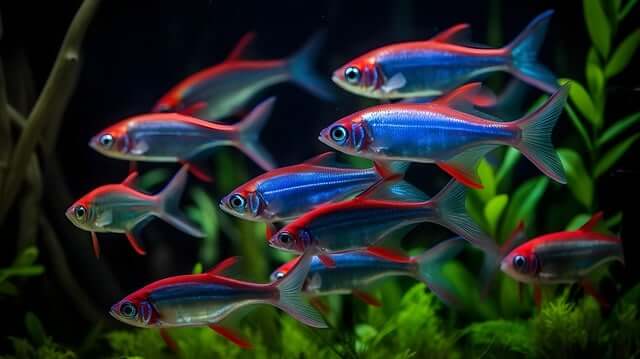
Tetra Tank Mates For Beginners
Best Tetra Tank Mates and If you’re a devoted aquarist, you know that creating the perfect fish tank ecosystem is a labor of love. One crucial aspect of this endeavor is selecting the right tank mates for your tetras. These dazzling, colorful fish can thrive in harmony with various species if you make informed choices. In this article, we’ll dive deep into the world of Tetra tank mates, exploring everything from compatibility factors to unique companions that will make your aquarium a vibrant aquatic haven.

Understanding Tetras
Tetras: A Diverse Family
Tetras belong to the Characidae family, a diverse group of freshwater fish originating from South America. Their diversity is astounding, with over 150 species and numerous color variations.
Notable Tetra Species
- Neon Tetra (Paracheirodon innesi): Known for its iridescent blue and red stripes, the neon tetra is a beloved choice among aquarists.
- Cardinal Tetra (Paracheirodon axelrodi): The cardinal tetra boasts striking blue and red hues, making it a showstopper in any tank.
- Black Skirt Tetra (Gymnocorymbus ternetzi): Recognizable by its long black fins, this tetra adds an elegant touch to aquariums.
Factors to Consider When Choosing Tank Mates
Compatibility
- Species Temperament: Matching temperament is essential to avoid conflicts, especially with the peaceful nature of tetras.
- Size Compatibility: Ensure that your tetras and their tank mates share similar size ranges to prevent bullying or predation.
Water Parameters
- Temperature: Tetras prefer slightly acidic water with temperatures around 75-80°F (24-27°C).
- pH Levels: Maintaining a pH between 6.0 and 7.0 is crucial for tetra health.
Diet Compatibility
- Carnivores, Herbivores, and Omnivores: Understanding your fish’s dietary preferences is essential to ensure they all receive proper nutrition.
- Feeding Habits: Some fish are top-feeders, while others forage at the bottom, so choose companions with compatible feeding habits.
Ideal Tetra Tank Mates
Peaceful Community Fish
- Guppies (Poecilia reticulata): These colorful and lively fish coexist peacefully with tetras.
- Corydoras Catfish (Corydoras spp.): Bottom-dwelling corydoras catfish are excellent companions that won’t disturb your tetras.
Shrimp Companions
- Cherry Shrimp (Neocaridina davidi): These small, vibrant shrimp add a pop of color to your tank.
- Amano Shrimp (Caridina multidentata): Amano shrimp are fantastic algae-eaters and peaceful tank mates for tetras.
Snail Partners
- Mystery Snail (Pomacea bridgesii): These snails are not only great cleaners but also fascinating to watch.
- Nerite Snail (Neritina spp.): Nerite snails are algae-eating experts that won’t disrupt your tank’s harmony.
Tetra-Specific Considerations
Shoaling Behavior
- Importance of Group Size: Tetras are shoaling fish, so keep them in groups of at least six to prevent stress and aggression.
- Avoiding Intraspecies Aggression: Provide hiding spots and break lines of sight to minimize territorial disputes.
Breeding Concerns
- Tetra Reproduction: Understanding tetra breeding behaviors will help you protect fry from becoming snacks for other tank mates.
- Protecting Fry: Separating fry from adults or providing ample hiding spots can boost their survival rate.
Avoiding Aggressive Tank Mates
Aggressive Fish to Avoid
- Cichlids: Most cichlids are territorial and may harass tetras.
- Betta Fish (Siamese Fighting Fish): Bettas can be aggressive, especially toward fish with similar colors or long fins.
Semi-Aggressive Species
- Gouramis: While beautiful, gouramis can sometimes exhibit territorial behavior.
- Barbs: Certain barb species may nip at tetra fins, causing stress.
Rare and Unique Tetra Tank Mates
Oddball Companions
- Kuhli Loaches (Pangio kuhlii): These eel-like loaches are fascinating additions to a tetra tank.
- African Butterflyfish (Pantodon buchholzi): With their unique appearance, these fish are bound to captivate your attention.
Biotope-Specific Tank Mates
- Tetra Biotope Tanks: Create a biotope tank that mimics the natural habitat of your tetras and include species native to that environment.
- South American Biotope Mates: Explore South American aquatic species to enhance the authenticity of your tank.
Introducing New Tank Mates
Quarantine Procedures
Quarantining new tank mates before introducing them to your main tank is a crucial step to prevent disease outbreaks.
Gradual Acclimatization
Slowly acclimate new additions to your tank’s water conditions to reduce stress and shock.
Monitoring Tank Dynamics
Keep a close eye on your tank’s inhabitants after introducing new members to ensure they adapt well and exhibit peaceful behavior.
Potential Challenges
Disease Transmission
Be vigilant about disease prevention, as some tank mates might carry illnesses that could affect your tetras.
Aggressive Behavior
If you notice aggressive behavior, consider rehoming or isolating the aggressor to maintain harmony.
Dietary Conflicts
Ensure all fish receive their required nutrients, and watch for any signs of dietary conflicts.
Maintaining a Harmonious Tank
Regular Water Testing
Frequent water parameter checks help ensure a stable and healthy tank environment.
Balanced Feeding
Offer a varied diet to meet the nutritional needs of all your tank’s inhabitants.
Monitoring Behavior
Observing fish behavior can help you spot issues early and take appropriate action.
Success Stories from Tetra Keepers
Testimonials from Experienced Hobbyists
Learn from experienced aquarists who have successfully maintained harmonious tetra tank communities.
Photos of Vibrant and Thriving Tanks
View stunning tank setups showcasing the beauty of tetras and their compatible tank mates.
Conclusion
The Joy of Companionship
Selecting the right tank mates for your tetras can result in a thriving and visually captivating aquatic world.
Responsible Fish Keeping
Remember, responsible fish keeping entails research, patience, and a commitment to the well-being of all your aquatic friends.